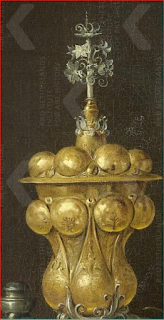The painting ,while not brilliant, was a lot better than most anonymous still lifes, and featured a "buckelpokal" or "pronkbeker", an elaborate gilded or golden cup, often with bulbous elements, and usually with a sculpted ornament on the top (often in silver). I already discussed another still life with such a cup in a post from October 2015.
The cup in the work for sale is quite distinctive, with what appears like a crowned thistle at the top. Perhaps this points to some connection with Scotland? In any case, looking at other lobster still lifes, I wa slucky enough to find the same or a very similar cup in some works by members of the Mertens family.
Wouter Mertens, sold at Sotheby's in 2006 for $385,000
There are two or three Mertenses who painted still lifes in the second half of the 17th century. The first is Wouter Mertens, who signed W. Mertens and probably was from (or at least trained in) Antwerp. The majority of the handful of signed works by him are still ifes with a lobster and fruit.Then we have Cornelis Mertens, who may or may not be the same artist, but definitely is closely related. Cornelis was a pupil in 1644, a master in the Antwerp Guild of Saint Luke by 1656, and died in 1698. We know that he painted still lifes, but only works signed W. Mertens are known, none by C. Mertens.
Thomas Mertens, sold at Sotheby's in 2015 for $43,000
Thomas Mertens (or J. Van Son), sold at Lempertz, 2016, est. 40.000€
This brings us to the link between the two (apart from the last name of course): Thomas Mertens. Thomas was probably the son of Cornelis, but his works closely resemble these from Wouter Mertens, and copy multiple elements from them. His oldest known work is from 1666.The painting for sale most closely resembles elements from the works of Wouter Mertens, but seems to lack his very high quality. Either the work has deteriorated over the ages (restorable or not), or the work is by a skilled follower, most likely Thomas Mertens. Some examples of similarities with the Wouter Mertens shown above can be seen in the cup, but also the way the peach is presented, the way the skin of the lemon is painted, and the use of the background (with a curtain on the right and a cord for the curtain on the left).
Especially the cup is a definig factor in my opinion. Such pokals were very expensive and all were one-off show pieces. I have not encountered examples of the same cup appearing in the work of unrelated artists, although it may of course have happened. This one is quite distinctive, not so much the lower, golden part (although the double row of globes and then underneath and between it the elongated forms are obviously the same), but especially the upper, silver bit. Very often this was either a sculpture (Saint Michael or Saint George seems to have been popular), or a geometric form. A more natural, floral form like the thistle(?) here is more unusual, and this specific one seems to be unique.
It can be compared to an example from the Victoria and Albert Museum, made ca. 1620. It has the same pattern below, and a similar but not identical decoration at the top. This type was apparently mainly made in Nurnberg, Germany.
A W. Mertens from the Heinz Collection in Washington, which I could only find in this pdf by Lorenzetti and with some very poor colour photos online, again has a similar cup, and a lobster and basket which are very similar to the one on the work here.
Some works by Thomas Mertens have the same elements, and are in execution closer to the work for sale here, so I would suggest, despite the apparent lack of a signature, that this is a work by Thomas Mertens. As such, it should be worth about 10,000€, maybe more if it can be cleaned or restored to its full glory.
UPDATE: sold for 3,400 Euro only.


















No comments:
Post a Comment